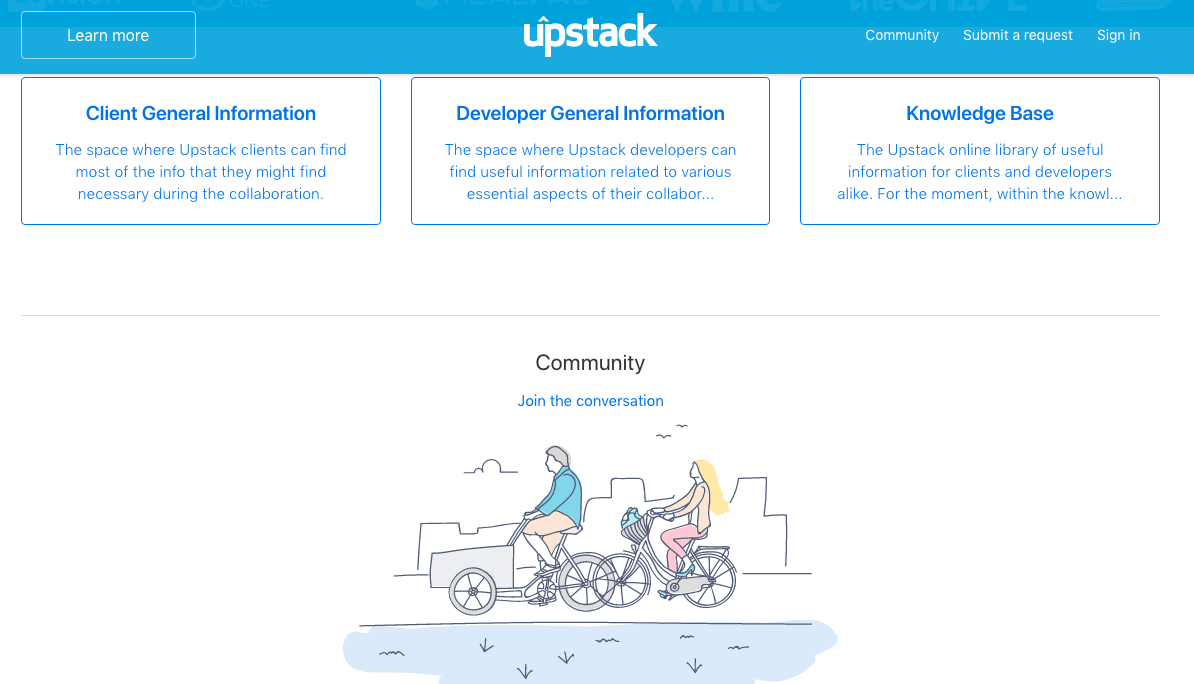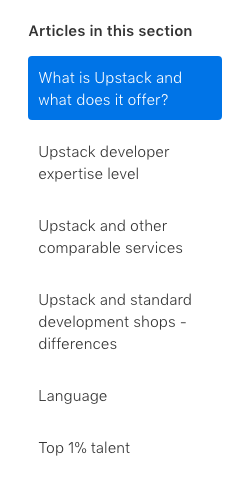Upstack Wiki Pages

Upstack Wiki Pages

Here at Upstack, we're trying to gather distributed engineers from all over the world and build up the largest community of this kind.
Building such a community requires also a lot of communication. Thus, Upstack's Wiki Pages were born!
Upstack Wiki is a blend of information, starting from basic questions that the client or the developer might ask and end up with successfully proven work methodologies from Agile Software Development.
How an idea can become a growing project
Our founder Yossi Mlynsky, the general manager George Cretu and the client success manager Robert Dragnea got together and decided that Upstack needs an onboarding manual for both developers and clients. Realizing that even with a manual some things might not be fully answered, a new idea began its contour.
We needed something that can grow with us. An organic page that can expand with the needs and requests from the company, developers, and clients. Once per week, these 3 great brains get together, and, following client and developer feedback, they try to analyze and improve all possible and impossible details.
One of the greatest aspects of this project is that anybody can collaborate with other users, can create interesting content, and then watch it help others as well.
Structure
The Wiki page consists of 3 basic aspects and a plus one:

1. Client general information
This is the space where Upstack clients can find most of the information that they might find necessary during the collaboration as follows:
Advantages of working with Upstack
We’ve developed a smart infrastructure and intense screening process to find only the best talent the world has to offer. However, talent is just one part of what makes us stand out. We also provide management of your remote team allowing you to focus more on the business while we handle all the things going on behind the scenes to make sure that your team is working at maximum efficiency.
Building your Upstack team
On Upstack's website, you can find a simple 4 step procedure to register as a company and follow through the process of hiring developers. Once your application is approved, you can create your 1st job. Once the job is created, an Upstack Account Manager will help you out to get the process to the next level: preparing for you a list of developers that match your requirements and company. After this, everything should run smoothly: getting to know the proposed developers, hiring them, and building awesome projects.
Procedures and expectations
We're very open about how we like to collaborate and have presented upfront our methodology of invoicing, payment, time-sheets from developers, how we like to communicate, and the major step with any distributed Agile organization: the daily standup.
Holidays and Notices
This involves the working schedule of developers, how we handle holidays as we work with teams from all over the world, and of course what happens when a developer leaves.
Intellectual property
We wanna make sure that the client fully understands that the projects that our developers build are the client's property and we make sure of IP protection.
Geography
As we are spread all over the world, we wanna make sure the client understands where the administration is and how timezones work out for them and the developers.
2. Developer General Information
Space where Upstack developers can find useful information related to various essential aspects of their collaboration with Upstack.
Getting a project trough Upstack
Here at Upstack, we work on a 2 interview basis, one being a “get to know you” interview where we talk about the work ethics and responsibilities and of course you as a developer; and a second interview which is a technical meeting that involves a few tasks to be done in real-time with live coding and screen sharing. After you pass the interview, the next step would be for us to build you a great Upstack Profile that acts out as your business card and is the one responsible in getting your matches with the client's needs and of course projects.

Responsibilities & Time Tracking
As with any distributed Agile organization, we make use of daily meetings that exist to inform the client/stakeholders of the team’s progress. We emphasize that our teams adhere to these guidelines, for various reasons, primarily because it is a tried and proven method of success in the Agile methodology. We don't use any weird software for keeping time, just a Slack time tracking bot, which is an internal feature of the Upstack Slack that enables developers to quickly update their timesheets. Once you are on board with a new project the company shall set you up on our portal and the bot will start asking you for updates daily.
Invoicing, Payments, and Holidays
Another method that is making things easier for developers was our choice of invoicing, as all invoices are sent from the Upstack portal every 2 weeks and paid from Payoneer Payment System, the easiest method that involves a global aspect. We also respect and tend to your holiday needs as our procedure ensures that stakeholders are swiftly made aware of any upcoming holidays that any Upstack team member might have.
3. Knowledge base
The Upstack online library of useful information for clients and developers alike. For the moment, within the knowledge base, you can find pertinent information regarding AGILE and Popular Project Management Software. We aim to make this section organic so that it grows as we enlist knowledgeable contributors, that will update it with relevant content.
We also have an active Community, the place where anybody can ask questions or start threads. The Help Center community consists of posts and comments organized by topic. Posts might include tips, feature requests, or questions. Comments might include observations, clarifications, praise, or any other response that's part of a typical community discussion.
